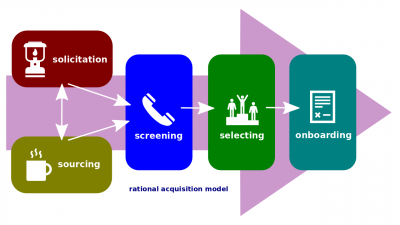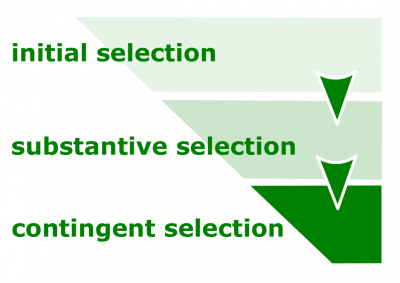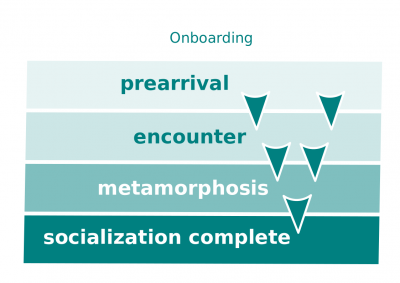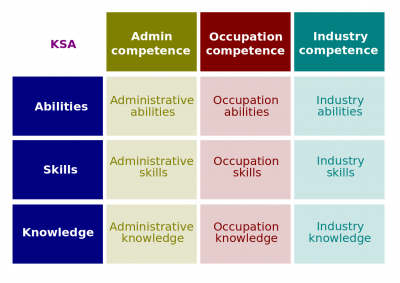Sourcing Essentials
The Sourcing Essentials (hereinafter, the Lesson) is the lesson of CNM Cyber that introduces its participants to recruitment and related topics. The Lesson belongs to the Introduction to Recruitment session of the CNM Cyber Orientation.
The Lesson is made up of three lectios. At CNM Cyber, the word, lectio, is used for a lesson part.
Contents
Summaries
Predecessor
- The predecessor lesson is Recruitment Essentials.
Outline
Successor
- The successor lesson is Sought Competences.
2019 Recruitment Overview presentation
The video of the presentation is published at https://youtu.be/u9C98gvUicI (4:44). Here is its full text.
Overview
- Welcome to Recruitment Overview. In this brief presentation, we are going to take a look at the general recruitment process, while making special stops by selection and onboarding topics. Let's go into.
What recruitment is
- Recruitment is the process of filling job vacancies with people, to understand the process we will use illustration which represents the rational acquisition model. The process starts with solicitation and sourcing. So let's say recruiters got order from an employer that for instance we need to fill a vacancy of a book keeper who used to know debit, credit, balance sheet and income statement.
- And recruiters start to try to understand where these people can be, reach out to the people and to ask or to understand whether these people are looking for a job or are available for a job then the screening process, so recruiters start asking if candidates match the employee requirements. Sometimes hiring managers can be involved in screening but the first preliminary screening is almost always accomplished by recruiters. Then recruiters find several candidates and they give information to hiring managers, then hiring managers make a decision, who from those candidates, who is more qualified and who will be selected.
- After selection, onboarding process starts. Recruiters may or may not be involved in selecting onboarding, sometimes they are, sometimes they are not.
Source selection
- We take a look at selection better and selection process. The selection goes in three stages; we believe that this candidate can possibly be qualified. Substantive we know this person is qualified but even if we know and if we like the person as an employment candidate and give an offer, usually this offer is contingent selection. So, this offer is contingent on the result of the test or maybe some probaratory period or work or something else.
Onboarding
- Finally, we take a look at onboarding, onboarding is a mechanism of integrating a new employee into the enterprise and it`s culture. Onboarding goes several stages as well, the first stage is pre-arrival, the candidates just heard about for instance Educaship Alliance LLC, and he or she can review materials online, you tube, website then encounter stage comes in, then the employment candidate and employer meet together. If the selection is made that metamorphosis stage comes into the place and here the documents are signed and an employee get costumed into the organization culture, and the organization itself gets a costumed to a new employee.
Summary
- This concludes the Recruitment Overview presentation. We have defined recruitment and used the rational acquisition model to take a look at the recruitment process. Special considerations were given to source selection and onboarding. If you haven't done yet so, you are now welcome to move to Recruitment Needs.
2019 Recruitment Needs presentation
The video of the presentation is published at https://youtu.be/-EsbkmuBcJ4 (4:17). Here is its full text.
Overview
- Welcome to Introduction to Recruitment. In this brief presentation, we are going to define recruitment needs and take a look at how recruiters identify what they would like to hire. Let's make it happen.
What a recruitment need is
- In recruitment needs, when the employer identifies the need of bringing someone on the boat, they need to create a statement. Usually the statement of the needs. Usually the statement is a result of job analysis or an assessment that defines jobs and behaviors and as a result the statement can be expressed in job description which is a written statement that describes job.
- Sometimes employers, let`s say department does this work, it creates a job description, sometimes recruiters do that. At least recruiters usually overview some addition or their opinions because usually recruiters post job descriptions.
Credential creep
- We are going to discuss a phenomenon known as Credential Creep. Recruiters usually are bureaucrats and tend to increase requirements for the job. If an employer brings a need or department brings a need for an accountant, a recruiter thinks there is going to be too many responses and pushes the requirement higher. For instance, adds a master’s degree in accounting as one of the requirements. So an employer needs an accountant who does balance sheet and income statement but recruiters add an additional requirement to this. This phenomenon is called Credential Creep.
KSA
- There is no any one single way to describe job and no single way to describe job description, we at Educaship Alliance LLC use something called KSA`s and these stands for knowledge, skills and abilities. Why? Because the United States Government use this KSA`s for their job openings. KSA is a description of what related competence in the series of narrative statement.
- Going over this, the first comes knowledge, knowledge is the part of knowledge applied directly to a particular occupation and industry and skills is technically work related skills and abilities is the set of capacities. What is the difference between skills and abilities? Skill is a learnt ability, but ability is the capacity to do something more just like learned skills.
- From the review of the previous section, we know that any competence or work related competence can be chunked into administrative occupation required and industry related, we can create some kind of a matrix or a table that we can chunk further for instance administrative competence can include administrative knowledge, skills and abilities and vis versa. Abilities can include administrative abilities, occupation required and industry related.
Summary
- This concludes the Introduction to Recruitment presentation. We have defined recruitment need and taken a look at the tools that recruiters use to identify a profile of a successful candidate including job descriptions and knowledge, skills, and abilities. A special stop was made by credential creep that some say is a recent trend in recruitment. If you haven't done yet so, you are now welcome to move to Finding Candidates.
2019 Finding Candidates presentation
The video of the presentation is published at https://youtu.be/ng6m0lR00zE (2:44). Its full text is below.
Overview
- Welcome to Search for Job Candidates. In this brief presentation, we are going to take a look at how recruiters look for candidates to hire. Let's undertake.
Search through internal sources
- How recruiters find potential candidates. One of the most reasonable is to check the organization`s database. Before we have someone who work for us or submitted their resume and we like the person but we were not ready to give an offer but now we are and we can reach out to the person and ask if he/she is interested in the position available that matches their profile.
- Because screening usually is an expensive process, e-network messages is one of the most reasonable resource where by instead of posting vacancy on the website, the organization may just send an e-mail to its employees stating the vacancy and inquire information on anyone who matches the organization`s profile. Assuming, if this person is already an employee, he/she can apply and basically the screening process is complete and onboarding is made easier.
Search through external sources
- Employment resource is another popular tool, an organization can go to any resource, usually web-based that allows matching employers and employment candidates. You can search by typing the position you want to fill. Let`s say an accountant. Someone will pop up and you are able to screen the person if he/she could be a good match and reach out to the person. This way, you will get a lot of responses some of them could be good but most of them would not.
Summary
- This concludes the Finding Candidates presentation. We have defined sourcing and taken a look at internal sources such as ERP human resources and in-network messages, as well as external employment resources. If you haven't done yet so, you are now welcome to move to Applicant Selections.




